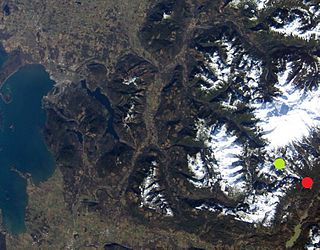Related Research Articles

Oso is a census-designated place (CDP) in Snohomish County, Washington, United States. It is located to the west of Darrington, south of the North Fork of the Stillaguamish River and approximately 50 air miles (80 km) from Seattle. The population of Oso was 172 at the 2020 census. The area was the site of a large landslide in March 2014 that killed 43 people, the deadliest incident of its kind in U.S. history.

The Snoqualmie River is a 45-mile (72 km) long river in King County and Snohomish County in the U.S. state of Washington. The river's three main tributaries are the North, Middle, and South Forks, which drain the west side of the Cascade Mountains near the town of North Bend and join near the town of Snoqualmie just above the Snoqualmie Falls. After the falls the river flows north through rich farmland and the towns of Fall City, Carnation, and Duvall before meeting the Skykomish River to form the Snohomish River near Monroe. The Snohomish River empties into Puget Sound at Everett. Other tributaries of the Snoqualmie River include the Taylor River and the Pratt River, both of which enter the Middle Fork, the Tolt River, which joins at Carnation, and the Raging River at Fall City.

Mount Baker Wilderness is a 119,989-acre (48,558 ha) wilderness area within the Mount Baker-Snoqualmie National Forest in the western Cascade Range of northern Washington state. Its eastern border is shared with the boundary of the Stephen Mather Wilderness and North Cascades National Park for a distance of 40 miles. The wilderness extends from State Route 20 north to the Canada–US border. On the west, it is bounded by the foothills of the Puget Sound lowlands.
Blum Creek is a small glacial tributary of the Baker River in Washington state, in the United States. It is sourced from the Hagan Glacier and another unnamed glacier on the north face of Mount Blum, and flows approximately 1.5 miles (2.4 km) from there to its mouth at the Baker River. Hagan Glacier is located below Mount Blum and the creek is also fed by runoff from the Blum Lakes, a set of six lakes south of Bacon Peak. The creek joins the Baker River two drainages downstream of Sulphide Creek, another Baker River glacial tributary. Blum Creek forms the waterfall Blum Basin Falls as it tumbles down a 1,680-foot (510 m) glacial cliff. The creek's watershed is an overwintering location for the local Rocky mountain goats.
The Little Chilliwack River is a small river in Whatcom County, Washington. It is a tributary of the Chilliwack River, entering the river just below the Canada–United States border.
The Rapid River is a tributary of the Beckler River in the U.S. state of Washington in the United States. It is 13 miles (21 km) long, with a drainage basin of 41 square miles (106 km2).

The Dickey River is a stream on the Olympic Peninsula in the U.S. state of Washington. It has three main forks, the East Fork, West Fork, and Middle Fork Dickey Rivers. The main stem is formed by the confluence of the East and West Forks. The river and its forks rise in the northwestern part of the Olympic Peninsula and flow generally south and west to join the Quillayute River near its mouth on the Pacific Ocean.
Rio Vista is an unincorporated community in the City of Richmond, in the U.S. state of Virginia. Located at intersection of Three Chopt Road and River Road.
Leech Creek is a stream in Columbia and Sauk counties, in the U.S. state of Wisconsin.

The Koma Kulshan Project is a 13.3 MW run-of-the-river hydroelectric generation facility on the slopes of Mount Baker, a stratovolcano in Washington state's North Cascades. The project commenced commercial operation in October 1990, and is owned by a Covanta Energy–Atlantic Power joint venture. It supplies Puget Sound Energy via a Power Supply Agreement (PSA) contract. Its single turbine is a Pelton wheel supplied by Sulzer Escher Wyss.
Boyd Creek is a stream in the U.S. state of Washington.
Grandy Creek is a stream in the U.S. state of Washington. The creek was named after John Grandy, a pioneer settler.
O'Toole Creek is a stream in the U.S. state of Washington.
Panther Creek is a stream in the U.S. state of Washington. It is a tributary of the Wind River.
Pressentin Creek is a stream in the U.S. state of Washington.
Hamilton Creek is a tributary stream of the Columbia River in Skamania County, in the U.S. state of Washington.
Sunday Creek is a stream in the U.S. state of Washington. It is a tributary of the Green River.
Illabot Creek is a designated National Wild and Scenic River in Northern Washington which provides a spawning and rearing habitat for summer and fall chinook, coho, chum and pink salmon; as well as steelhead and bull trout. The creek is in the Skagit River watershed. Puget Sound Chinook, steelhead and bull trout are listed under the Endangered Species Act. Illabot Creek also supports the highest density of chum and pink salmon in the Skagit River watershed. The creek area also provides habitat for wintering bald eagles that are attracted to the salmon, part of one of the largest concentration of wintering bald eagles in the continental United States.
References
- ↑ U.S. Geological Survey Geographic Names Information System: Jackman Creek
- ↑ Meany, Edmond S. (1923). Origin of Washington geographic names. Seattle: University of Washington Press. p. 122.
48°31′22″N121°43′05″W / 48.52278°N 121.71806°W